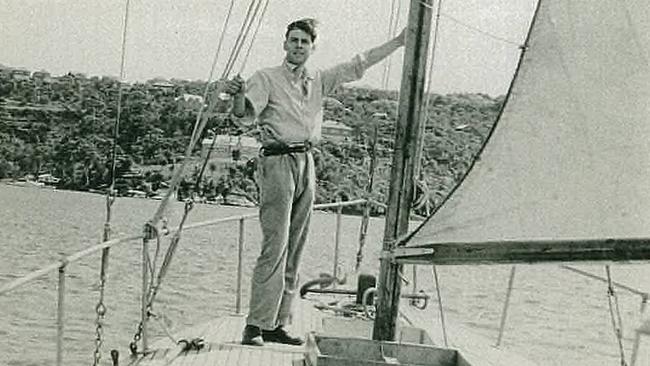First Hobart race sailed into a perfect storm
CHEERS, handclaps and honking car horns greeted the ketch Wayfarer when she finally sailed into Hobart, 11 days after setting sail on the first Sydney to Hobart yacht race.

Today in History
Don't miss out on the headlines from Today in History. Followed categories will be added to My News.
Cheers, applause and honking car horns greeted the ketch Wayfarer when she finally sailed up the Derwent into Hobart, 11 days after sailing out for the first Sydney to Hobart yacht race on Boxing Day, 1945.
Arriving last from nine starters didn’t phase her skipper Peter Luke, perhaps still a reluctant competitor after his holiday cruise to Hobart was hijacked to become Australia’s first serious yacht race.
The Wayfarer had been out of contact since striking a gale on the NSW south coast on December 28 and did not sight another craft until she reached the Derwent on the evening of January 6, 1946.
The night before, Luke and his four-man crew anchored at Port Arthur, where they rowed ashore to contact relatives and spent the night at the Arthur Hotel. Publican Tasman Pitman put on a barrel of beer in their honour, their first draught beer since Boxing Day. Resident Derwent Martin also treated the sailors to supper of pork and crayfish, described by Luke as “the gastronomic highlight” of their voyage.
The son of a photographer and an avid sailor, in 1944 Luke joined Charlie Cooper and nine other sailing enthusiasts to establish the Cruising Yacht Club for yachtsmen who didn’t want to race. Luke also invited the founders, who enjoyed cruising as opposed to racing, to join a post-Christmas cruise to Hobart.
The cruise plan was swamped when Luke invited British Royal Navy engineer Captain John Illingworth, based at Garden Island, to join the cruise. Illingworth, already a noted sailor and yacht designer who started racing in Japanese and Hong Kong waters while posted to Japan from 1927-29, immediately suggested “Why don’t we make a race of it?”
The race quickly attracted 10 entries, with sail sizes from 500-2000 square feet, although nine started and only eight crossed the finish line. It adopted intricate Royal Ocean Racing Club handicap rules to equalise such factors as high freeboard, heavy hull construction, deep hulls, bulwarks, propellers, cruising and racing craft.
The race began on Sydney Harbour at noon on Wednesday, December 26, 1945, before heading south for 630 nautical miles (1170km) through the Tasman Sea, across Bass Strait, into Storm Bay and up the Derwent River. Other starters were John Colquhoun and Clarrie Kiel’s Ambermerle, purchased on December 9, 1944; Phil Goldstein’s Archina; Jack Earl’s Kathleen; J.R. Bartlett’s Horizon; Robert Evans’ Mistral II; Bert and Russ Walker’s Saltair and Tasmanian Percy Coverdale’s Winston Churchill.
Illingworth’s vessel Rani, a double-ended 10.6m craft built in Sydney to a design by Arthur Barber, was the smallest starter. Illingworth enlisted young Royal Navy officers and local amateur yachtsmen for his crew.
Less than two days out, the fleet ran into a southerly buster, a 36-hour blow that developed into a force-9 gale off the NSW south coast, forcing Goldstein’s Archina to retire.
The gale also fanned interest as newspapers reported that Rani and the ketch Horizon had been missing from 24 hours after the start. RAAF Catalina sea plans conducted futile searches, but Illingworth’s wife told reporters she was confident her husband and his yacht would reappear.
Victoria’s Royal Prince Alfred Yacht Club telegraphed RAAF headquarters in Melbourne to request an organised search, while a Catalina flew down the coast making 100-mile sweeps out to sea.
Newspapers also interviewed the family of Horizon crew members, who included future America’s Cup designer Alan Payne and Sydney yacht builder Englebert “Boy” Messenger, whose yachtsman father Ernie was “confident” the yacht would reappear. By New Year’s Day, 1946, Bartlett’s wife was too ill to be interviewed.
The Rani reappeared about 4pm on New Year’s Day in Storm Bay and crossed the finish line 1.22am on January 2, after 158hrs 22min 35secs sailing, corrected on handicap to 124hrs 17min 49secs. Illingworth was surprised to be first up the Derwent, and shocked that his vessel was not spotted in aerial searches.
“I cannot understand why they thought we were missing because we saw the Catalina pass over us twice,” he said. “We are small, of course, and at the time were not carrying much sail.”
Six hours after Rani finished, a Catalina spotted the Horizon, which had not been sighted for six days, 80 miles from Hobart.
Luke’s Wayfarer lost sight of other yachts in the race on their first night out, and didn’t sight another craft until they entered the Derwent estuary. The Wayfarer drifted for nearly all of New Year’s Day and days later sheltered overnight at Schouten Island, off Tasmania. They finished at 5.21pm on January 6 after 270hr 21m sailing time, corrected under handicap to 187h 43m 52s. “We enjoyed every minute of it,” Luke enthused.
He died in 2007, the last surviving skipper from the 1945 event.
marea.donnelly@news.com.au


